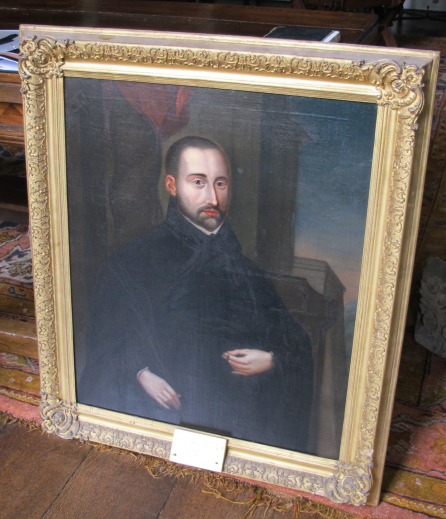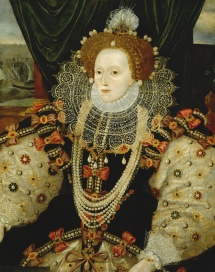In the run-up to the Lost Treasures Exhibition (from 20th October-24th February), we will be shining the spotlight on a selected number of objects to give you an exclusive preview of what is to come at Strawberry Hill this Autumn. This week we gain insight into the story of Horace’s ancestor, St. Henry Walpole, the Jesuit martyr who was cruelly executed during the reign of Elizabeth I.
St Henry Walpole – Strawberry Hill’s Visiting Saint
Written by Carole Tucker
Our research co-curator, Dr Sivia Davoli, has succeeded in tracking down the portrait of St Henry Walpole by an unknown artist which once hanged in the Plaid Bedchamber at Strawberry Hill and will return there for the Lost Treasures Exhibition. 
According to Horace’s account, Henry Walpole was executed for attempting to murder Queen Elizabeth I, but it was actually his brother, Richard, who was implicated in the plot to poison her. Not for the first time, Horace’s desire for a good story appears to have got in the way of the facts!
Henry Walpole was born in 1558 and, while in London training to become a lawyer, he witnessed the horrific execution of Father Edmund Campion, the Jesuit priest. Bespattered by Campion’s blood as his heart was torn from his body, Henry resolved to devote himself to the Catholic cause for which the priest had died. He left England and was ordained in Paris in 1588.
In 1593, Walpole was sent on a Jesuit mission to England together with his younger brother, Thomas, and another priest. Unfortunately, bad weather meant that they could not be put ashore on the Norfolk coast, which was familiar to the Walpole brothers, as planned but, instead, the ship carrying them continued up the coast eventually landing them at Bridlington. One of the other passengers hurried away to betray the priests. In unfamiliar territory, travel-stained and rain-soaked, it was easy for the authorities to apprehend the brothers and take them to York Castle.
Although Henry was made of sterner stuff, his young brother told the authorities all they wanted to know. Henry was taken down to London, imprisoned in the Tower and racked so often and horrifically that he eventually lost the use of his hands. He was finally returned to York where he was executed on the 17th April 1595 aged 36 years old. As a Jesuit priest, he was accorded the agonising death of being hung, drawn and quartered. Henry Walpole was later canonised in 1970.
So, what of Henry’s brother Richard?
Richard had followed his brother to France where he too was ordained. From then on, he spent most of his time in Spain. While working in Seville he was introduced to an

Englishman, Edward Squire. The plan was that Walpole should convert Squire to Catholicism, though Richard seems to have had doubts about the man’s sincerity. After Squire’s return to England, he was arrested and accused of attempting to poison the Queen by rubbing poison into the saddle of her horse while he was working in the Queen’s stables. He was also accused of an attempt on the life of the Earl of Essex by poisoning his chair. Under questioning, he accused Richard Walpole of instigating the plot although on the gallows, before being hung, drawn and quartered, he withdrew his confession. The improbabilities in this story suggested that it was worked up, possibly by Sir Robert Cecil, as a propaganda exercise against the Jesuits. Father Richard Walpole remained in Spain until his death.
A Curious Postscript!
The main source of this story is “One generation of a Norfolk House: a contribution to Elizabethan history” by Augustus Jessopp written in 1913. Jessopp was a friend of M.R. James, who is best known for his collection of ghost stories. So perhaps it is unsurprising that while he was researching this book a ghostly cleric came to visit him!
“Why do I use my paper, ink and pen?”
‘Why do I use my paper, ink and pen,
And call my wits to counsel what to say?
Such memories were made for mortal men;
I speak of Saints whose names cannot decay.
An Angel’s trump were fitter for to sound.
Their glorious death if such on earth were found.
That store of such were once on earth pursued,
The histories of ancient times record,
Whose constancy great tyrants’ rage subdued.
Through patient death, professing Christ the Lord:
As his Apostles perfect witness bare,
With many more that blessed Martyrs were.
Whose patience rare and most courageous mind,
With fame renowned perpetual shall endure,
By whose examples we may rightly find,
Of holy life and death a pattern pure.
That we therefore their virtues may embrace
Pray we to Christ to guide us with his grace.’
Written by Henry Walpole following the execution of St. Edmund Campion
On loan from Lord and Lady Walpole